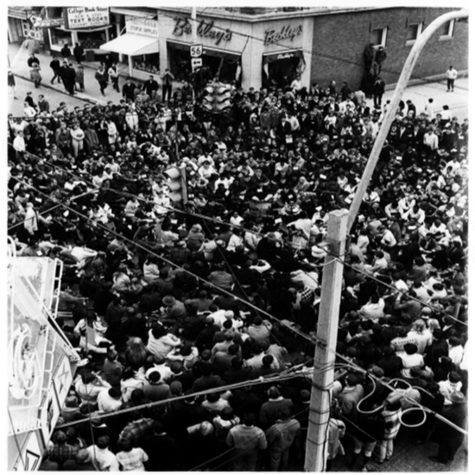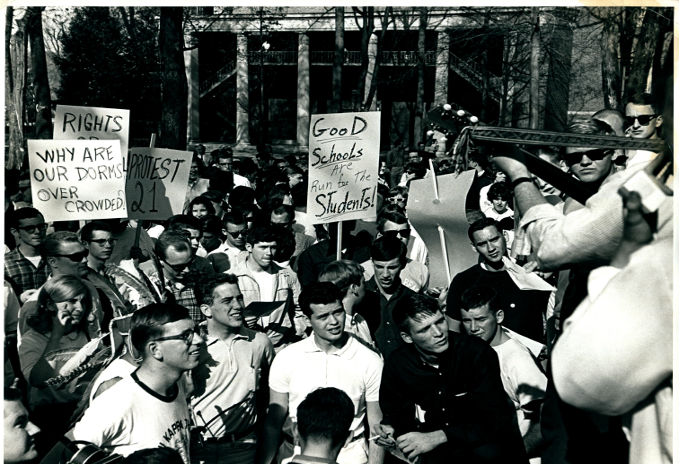
History of Free Speech and Activism at OHIO
There is a long legacy of free speech and expression at Ohio University. A plaque on College Green, the center of campus and home to Cutler Hall, reads:
“College Green has served as a forum for the voices of Ohio University’s students throughout its history. Whether supporting civil rights, advocating for the abolishment of women’s curfews, or in protest, students have and will continue to play a vital role in shaping Ohio University.”
Indeed, this legacy of encouraging student speech and activism is reflected beyond the College Green. An iconic feature of Ohio University is the “Graffiti Wall,” which has content continually managed by the community, not the University. Ohio University is home to an award-winning independent newspaper, The Post, and numerous other independent journalistic endeavors over the course of its more than 200-year history. The Green Goat, for example, was a satirical publication, first published in 1913, that showcased cartoons and other artwork challenging University policy and community social norms.
In addition to these more ongoing opportunities for free expression, Ohio University also has a legacy of protest. Over decades, Ohio University students (and other members of the campus community) protested an array of local, national, and international issues, such as overcrowded classrooms, inequitable treatment of women and minorities, the assassination of the Reverend Dr. Martin Luther King, Jr., the lack of an Afro-American Studies curricula, rising University tuition, the Vietnam war, abuse of migrant farm workers, among many others. The vast majority of these gatherings were peaceful. On rare occasions, protests turned violent or disruptive, resulting in arrests. Most recently, Ohio University students and others held rallies supporting the #blacklivesmatter movement, DACA, and civil rights as part of the annual Dr. Martin Luther King Day celebration. In short, Ohio University students have established a vibrant tradition of making their voices heard.
Yet while there has been a clear and consistent pattern of free speech, free expression, and activism at Ohio University, University policies have ebbed and flowed over the years. Early policies were, in fact, quite restrictive. One resolution passed by the Ohio University Board of Trustees in 1812 stated:

“It is required of all the students to treat all persons whatsoever with modesty, civility and due respect, but more especially, to exhibit at all time the most respectful deportment to the officers of the university in his lawful commands, and if any student shall willfully disobey any officer of the University in his lawful commands, or shall either in speech or action manifest disrespect towards the President, he shall be admonished and make due acknowledgement to the offended party, or be suspended, as the faculty may decide.”
Similarly, student attire was carefully regulated through the 1960s as documented in various rulebooks distributed to freshmen. Despite such restrictive policies, however, students and faculty were generally able to exercise free speech regularly.
President Vernon R. Alden was a pivotal figure in the history of free speech and expression at the University. In 1962, Dr. Alden created a “Speakers Policy” defending free speech and expression on campus. A photograph of that policy, provided by Mr. Kimok, is included here due to its historic importance.

Subsequent to President Alden’s progressive stand, various political and social issues sparked a series of protests on campus. As a result, University policies began to pay specific attention to regulating such activities. For example, the 1964 OU Men’s Handbook stated, “The participation in, incitement of, and/or aiding and abetting of a riot or demonstration may result in immediate suspension of the student from the University.” The 1966-67 Student Handbook devoted an entire page to the University’s positions on “Demonstrations.” The Handbook admonished, “Public displays should not interfere with the rights and privileges of others or with the orderly conduct of university affairs.”
The 1969-70 student handbook stipulated several time, place, and manner restrictions for the display of posters, banners, handouts, and painting of the kissing circle. In 1970, state police and National Guardsmen were brought to campus to manage protests against the Vietnam War and the killing of four students at Kent State University. In the wake of the Kent State shootings, reflecting student activities and Universities' reactions throughout the country, Ohio University closed on May 15, 1970, before the semester ended and did not re-open until August. More recently, in the early 2000s, Ohio University mimicked the trend at many other American universities and established “free speech zones,” a policy that was widely criticized because those designated "zones" were often in out-of-the-way places; court rulings, not directly involving Ohio University, have generally ruled that those zones are unconstitutional.
In short, the history of free speech and free speech policies at Ohio University is complex. Although Ohio University students and faculty always have exercised their right to free speech, the manner of their behavior has varied greatly. Likewise, the policies of the University have shifted over time. Today, once again, the University community is grappling with the changing nature of activism, free speech, and free expression and the University's related policies and practices.